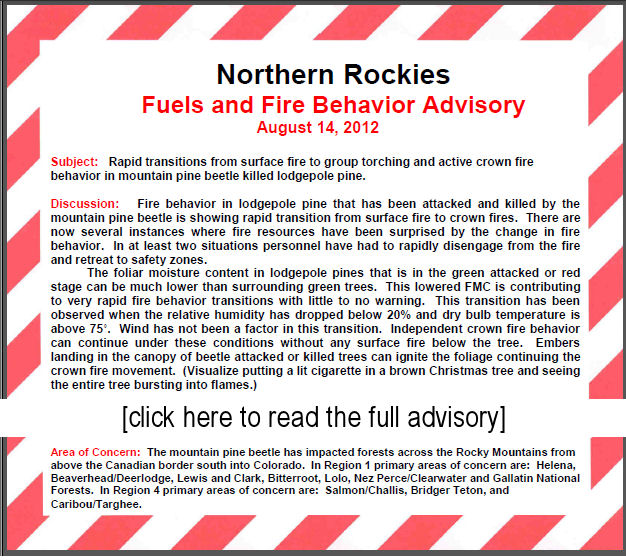The Northern Rockies Regional Fuel Planner, Stu Hoyt, has issued a Safety Advisory for areas affected by mountain pine beetle infestations. There have been several instances where crews have not been expecting the rapid transition from surface fire to crown fire in lodgepole pine in the green attacked and red needle stages. This advisory is posted on the predictive services website under Fuels and Fire Behavior Advisories and can be found on the Northern Rockies Coordination Center website under Outlooks.
 Concerns to Firefighters and the Public:
Concerns to Firefighters and the Public:
- Anticipate rapid transition of surface fire behavior to passive and active crown fire behavior when temperatures are above 75˚, relative humidity is below 20% and foliage is in sunlight.
- Wind is not needed to influence this fire behavior transition.
- Anticipate rapid fire growth in all directions as this is a fuels dominated condition.
- Anticipate long-distance spotting in any direction.
- Anticipate independent crown fire movement perpetuated by embers landing in the foliage of beetle-attacked or killed trees.
Mitigation Measures:
- Closely monitor fire weather conditions to maintain situational awareness.
- Track the probability of ignition.
- Utilize the table developed by the Missoula Fire Lab for Mountain Pine Beetle-attacked trees.
- Probability of ignition above 70% should be an early trigger point in decision making.
- At POI greater than 80% firefighters should be prepared for rapid transitions from surface to crown fire behavior.
- When initial attacking new fires in these conditions, if possible delay engagement to after peak burning period or early morning when fire behavior is low.
- Escape routes and safety zones must be identified before engagement.
- Using the green as a safety zone should not be considered.
- Identify at least two different Escape Routes and Safety Zones in case your original ones are compromised.
- Monitor and understand the effect that weather changes and topography have on fire behavior.
- Post lookouts who can see the flaming front.
For further information, contact Stu Hoyt at (406)329-3266 or (406)370-5757
